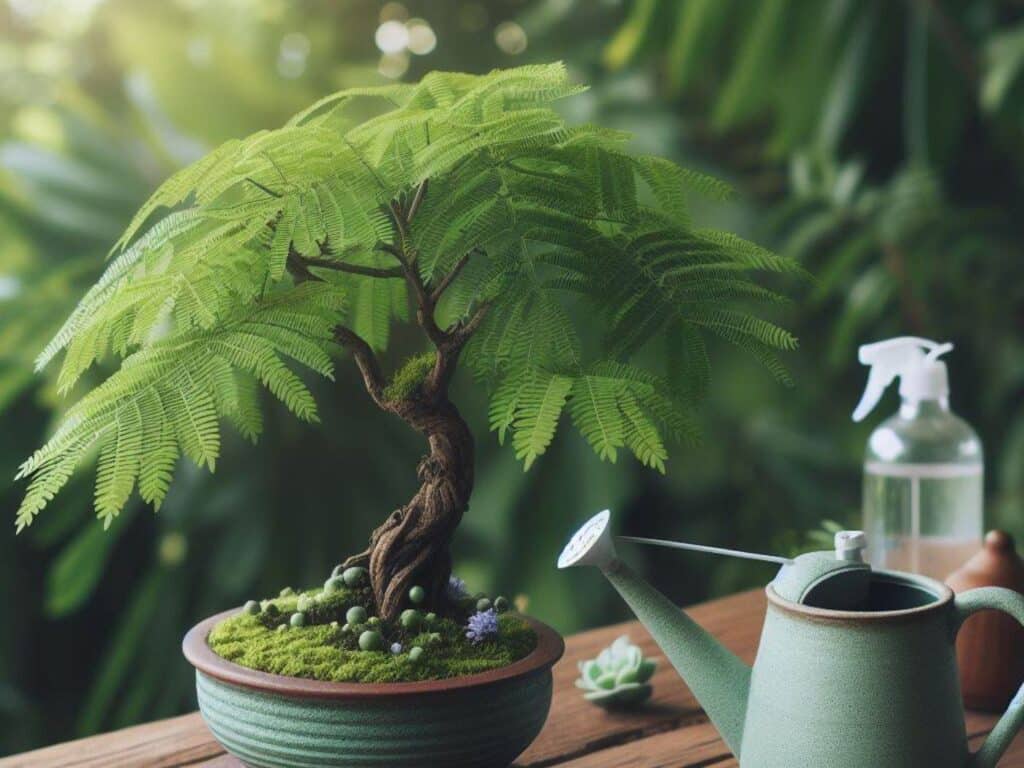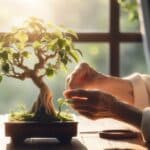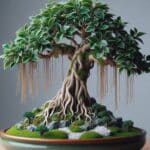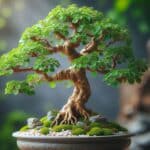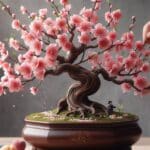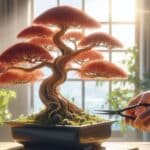Jacaranda trees, also known as Blue Jacaranda or Jacaranda mimosifoia, are some of the most popular ornamental trees because they can produce masses of long-lasting blue or purple flowers that can create quite an impressive display of color and charm.
If a Jacaranda flower falls on your head, it is good luck. This tree also represents wisdom, wealth, and rebirth.
These stunning trees are also sometimes used for growing bonsai trees because of their interesting foliage, and bright flower colors are ideal for creating miniature trees with a more exciting and unique appearance.
These specimen trees are very hardy and reasonably easy to grow but require some maintenance and special techniques to keep the tree small and attractive.
Let’s look at how to grow and craft a jacaranda mimosifolia bonsai.

Plant Facts
| Scientific name | Jacaranda mimosifolia |
| Common names | Jacaranda, Blue jacaranda, Black poui, Nupur or Fern Tree |
| Family | Bignoniaceae |
| Plant Type | Ornamental tree |
| Height and Width | 25 – 40 ft. tall (natural), 1–6 ft. wide (bonsai) |
| Origin | South Brazil, northwest Argentina, and southern Bolivia |
| Flower colors | Blue or purple flowers |
| Foliage color | Light green fern-like |
| Sun Exposure | Outdoor or indoor bonsai with lots of direct sunlight |
| Soil Type & pH | Sandy, well-drained soil |
| Special features | Produces vivid blue/purple blooms, fern-like foliage, medium maintenance |
What Does a Jacaranda Bonsai Look Like
Jacaranda bonsai trees do look quite different from all the common bonsai species. Unlike most miniature trees, they have fern-like foliage, and the leaves can grow quite large. The trees produce an exciting bark pattern with a light sandy color, and they are at their most striking when they make vivid purple flowers on long grouped panicles.
If the semi-evergreen tree is kept in warm climates, it can keep its foliage throughout the winter. The leaves will fall off during winter and re-emerge in colder regions in spring.
Where Does a Jacaranda Bonsai Grow
These trees prefer warm climates and should be protected during icy winters. It is usually best to keep a blue jacaranda bonsai outdoors during spring and summer so it can get plenty of sunlight. The fern tree’s foliage can, however, scorch in extreme heat.
Bringing your small tree indoors during winter is best to protect it from the cold. It should be positioned in a sunny window, or the tree can drop all its leaves. In indoor environments, you should be careful not to place the tree close to a heating device or air conditioner since these devices can cause damage.
How to Grow a Jacaranda Bonsai Tree
Jacaranda trees make fascinating specimen plants and are relatively easy to grow and train into bonsai form. Let’s look at how to grow this captivating subtropical tree.

Propagation
The easiest way to start a jacaranda bonsai is by purchasing a seedling from a local nursery. If you cannot find a young seedling then you can easily propagate jacaranda mimosifolia from a seed or from softwood cuttings.
Propagation From Seed
You can acquire seeds directly from the seed pods of mature trees. These seeds should be soaked in water for a day. Place the soaked seeds on a soil bed in a container and cover it with a thin layer of soil. The seeds should be kept moist until they germinate.
Jacaranda seeds usually take 14 – 28 days to germinate and germinate best if they are kept at 20 – 24 degrees C.
When the seedlings are strong enough, they can be transplanted into a more suitable container.
Propagation From Cuttings
You will need to take a few 6-inch softwood cuttings to propagate a jacaranda tree from green cuttings. Dip the cuttings into rooting hormone and plant them in a potting soil container.
Place a plastic bag over the cutting and container and open it daily to allow the cutting to breathe. The pot should be kept in a warm climate in the shade and moist until the cutting starts to sprout new growth.
Soil
Jacaranda trees grow best in a well-draining soil mix with a slightly acidic pH. These trees can grow well in most soil mixes but prefer sandy soil. It is best to plant your bonsai in a proper bonsai soil mixture with lots of gravel at the base of the container to promote drainage.
These trees can quickly die in waterlogged soil and should be placed in a container with many drainage holes.
Pruning
To turn your small tee into a bonsai, you must prune the tree and shape the branches into a desired shape.
These trees are mostly pruned to form one central leader or main trunk to strengthen the tree. A strong trunk is also helpful for creating a more mature-looking bonsai jacaranda.
From there on, the branches can be tweaked to create an exciting bonsai shape. It is usually best to focus on a simple bonsai style like formal upright or broom for these tree species.
Use aluminum or copper wire to coil around the tree branches if you want to alter their shape. The wires should be left on for about 3 months and removed before they start cutting into the tree’s bark.
This tree requires seasonal pruning, but this pruning task should be limited. Only the damaged, dead, or diseased branches should be removed.
A jacaranda mimosifolia bonsai tree has large and long fern-like foliage. The huge size of these leaf pairs makes the tree look unbalanced. To create a miniature appearance, the largest leaves can be cut off, and new shoots can be shortened to two leaf pairs when the branch has too many.
Repotting and Transplanting
Young bonsai trees must be repotted every two years, while mature trees can be repotted every 3 – 5 years.
It is best to repot the bonsai plants in early spring. These trees can be repotted to a more suitable bonsai pot before the growing season.
When repotting your little tree, you should use a proper bonsai container with lots of drainage holes. It is usually best to use a shallow bonsai pot for these trees. The container should be two-thirds of the tree’s height, and it is best to pick a container that goes well with the purple flowers or the foliage.
The tree should be planted in fresh bonsai soil. You can use commercial bonsai soil and add a thin layer of gravel to the base of the container to promote drainage.
The roots of this tree should also be pruned during repotting, or your tree won’t grow well in a small container. Be careful not to damage the tree’s root ball and remove about one-third of the root system.
Once the tree has been repotted, it should be kept in a warm, shaded area and kept moist until the tree recovers.
How to Care for Bonsai Jacaranda Trees
Jacaranda bonsai trees are not too difficult to care for but they do require regular watering, fertilizing, and care to keep them healthy and happy. Here is a quick look at a simple jacaranda bonsai care guide that can keep your tree in good health.

Water
Finding a good balance when watering your jacaranda bonsai can be challenging. This type of bonsai tree prefers moist soil because it can be damaged if the root ball dries out. Too little water can also cause the leaves to fall off. While keeping the plant slightly moist is good, you shouldn’t overwater the tree since waterlogged conditions can damage its root system.
The little tree will also need more water during warmer seasons compared to the more excellent winter times.
Sunlight
These trees prefer warmer temperatures and a lot of light. Protecting your small trees from cold temperatures is very important because they can easily die from frost.
It is usually best to keep this type of tree outside from early spring and through summer so it can receive about six hours of direct sunlight per day. You can use a shade cloth to protect the foliage during the hottest days.
In late autumn and winter, the tree should be brought indoors to protect the delicate foliage from the frost. While keeping it indoors, it is usually best to keep this small pet tree in a sunny window where it will receive as much warmth and direct sun as possible.
Temperature and Humidity
Bonsai blue jacaranda prefers warmer temperatures of over 15 degrees C. If the temperatures drop below 15 degrees C, the tree should be brought indoors or into a heated greenhouse to protect it from the winter chill.
Since jacaranda trees thrive in tropical regions, they typically prefer higher humidity levels. You can increase the humidity around your tree by moistening the foliage daily with distilled water in a spray bottle. Adding a humidity tray underneath your tree can also be a great way to raise the humidity levels if you are keeping the jacaranda bonsai indoors.
Fertilizer
This type of subtropical tree grows quickly during the growing season and requires a lot of nutrients to stay healthy. It is best to fertilize the bonsai with liquid fertilizer once a week during the growing season and once every two weeks during winter.
Pest and Diseases
Your charming bonsai can be damaged if it becomes infested with pests like aphids, and scale insects or if a fungal infection starts to grow on its roots.
Most common pests can be treated effectively with regular insecticidal soap or neem oil spray. If you notice any fungal infections around the roots then it is time to reduce watering or to place your tree in a sunnier area.
Common Varieties and Cultivars
There are quite a few different types of Jacaranda tree species and many are perfectly suitable for growing an impressive bonsai. Here is a quick look at some of the most common varieties used for bonsai creations.
- Blue Jacaranda Bonssi (Jacaranda mimosifolia)
- Bonsai Blue Jacaranda (Jacaranda mimosifolia Bonsai Blue (PBR))
- Boxwood Jacaranda tree (Jacaranda caerulea)
- Purple Fern Jacaranda Tree (Jacaranda cuspidifolia)
- Purple Velvet Jacaranda (Jacaranda jasminoides)
Conclusion
A jacaranda bonsai can be an exciting addition to your home. These trees are delicate and require regular care to keep them in tip-top shape, but they are worth all the effort because they will reward your efforts with the most impressive purple or blue flowers.
This type of plant is challenging to grow and care for, so it isn’t a perfect fit for beginners. However, growing a Jacaranda tree can enrich advanced bonsai growers’ experience.
We hope you enjoyed our guide, and if you decide to grow this type of purple flowering bonsai, we wish you all the best on your growing journey.
Up next:

